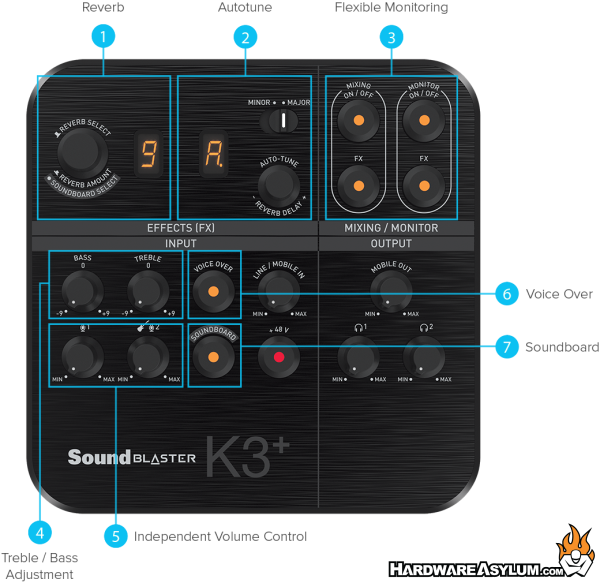Creative Sound Blaster K3+ USB Audio Processor Review
Author: Dennis GarciaTesting and Impressions
When I first fired up the Sound Blaster K3+ I was honestly looking for a driver disk. The system detected the device and never prompted me for anything this making me assume it was needing something. Nothing had installed and honestly, I didn’t think it would work. (Imagine that hardware just working when you plug it in!)
Moving on I checked my PC audio settings and noticed that the K3+ was indeed active so I started plugging in one of my R0de Procasters and a pair of headphones. After about 3 minutes of fiddling I was ready to record and was really impressed in the monitoring quality. I noticed Zero lag on the monitor mix and the audio quality was really good.
At the top of the unit there are four buttons related to mixing and monitoring. They are helpful so that you can hear what is being recorded and what effects are applied. Sadly every button click gets recorded as a loud snap so that will need to be moinitored and if you leave the FX monitoring enabled and don’t have any effects activated you get some weird feedback from the audio post processor.

Early in this review I talked about how I use the Focusrite Scarlett 6i6. This is a USB audio interface similar to the Sound Blaster K3+ however it is also externally powered. The extra power comes in handy when running Dynamic microphones and for high ohm headphones which is something most USB devices cannot deliver.
When I tried to run the Sound Blaster K3+ with my Procaster dynamic microphones I had to turn the microphone gain up all the way which not only introduced noise in my recording and still wasn’t loud enough. Lucky for me I have a couple Fethead pre-amplifiers that work to boost the dynamic microphone signal before it gets to the auto processor. The intent is that you to use less microphone gain and get cleaner sound. The Fethead requires phantom power and after a quick gain adjustment I was back to recording.
To be totally honest this is 100% what I had expected and also not required when recording on my Focusrite device.
On a positive anyone recording with an XLR condenser microphone will not have any of these issues when recording on the Sound Blaster K3+. The onboard phantom power and 24-bit audio processor do a great job at delivering high quality recordings and has the added benefit of being cheaper too.
The final item is the mixing effects and SoundBoard. Both of these are great features for the K3+ and given some time and tuning they can really add some value to your recordings and game streams. For instance playing the entrance sound when you start your stream and add a bit of Crow Caw with every death might be what your stream needs to stand out. Just be careful not to become a morning DJ by overusing the sound board.
Overall I really like the Sound Blaster K3+. It is extremely easy to setup and supports a wide variety of equipment configurations from standard XLR microphones and instruments to mobile singing apps, sound effects, auto tune and reverb. I can easily see this device being used for a variety of uses from game streamers, to amateur recording artists and casual podcasters. It isn’t' designed to compete with professional quality equipment but can deliver excellent quality sound with enhanced features at a reasonable price.
Dual XLR Inputs
Dual Headphone Outputs
High Quality Sound
RCA Line In and Line Out
Mobile Recording Ready
6 Modes of Operation
No Drivers Needed
Plug and Play
doesn’t support dynamic microphones well?
pressing buttons records clicks in output
dial a feature not easy
cannot change soundboard or canned effects

